August was another busy month for the search industry, with Google rolling out a major spam update, expanding AI Mode globally, and testing new ways to drive clicks from AI-powered results. Research also shed light on how people are still using traditional search.
Updates are colour coded by importance:
🔴 Major developments likely to impact strategy
🟡 Worth watching or understanding
🟢 Informative - but lower impact for most
Google Search
🔴 Google begins rolling out August 2025 Spam Update
Google’s latest spam update began rolling out on August 26 and will take “a few weeks” to complete.
Some SEOs are reporting significant rank shifting, but this change feels more pronounced due to the uncharacteristic stretch of calm recorded the week before the update (see below).
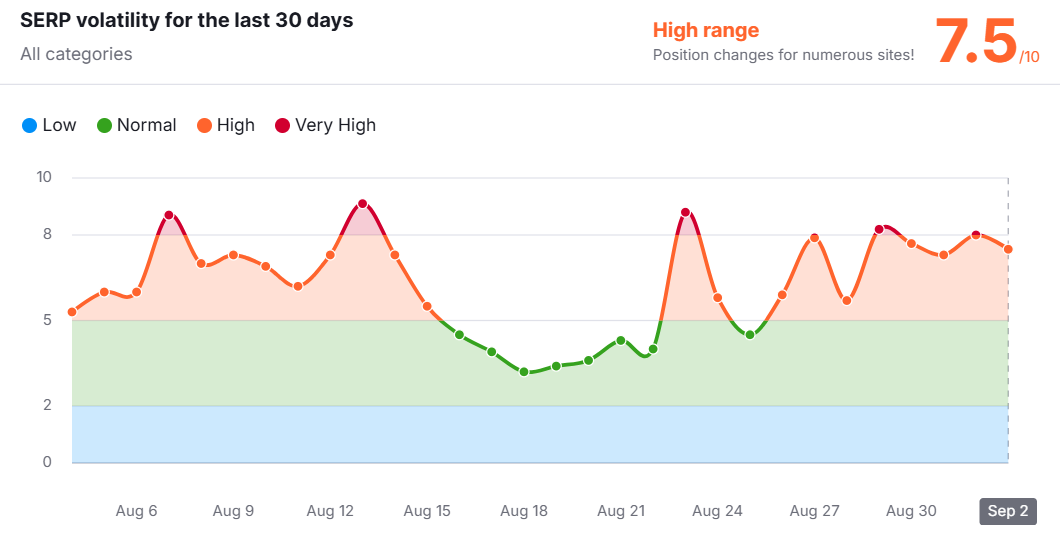
We will be covering this update in detail in our live guide to Google’s major updates once rollout is complete.
For site owners…
While Google hasn’t offered any specifics on the focus of this update, you can still safeguard your position by ensuring your webpages and practices are compliant with Google’s spam policies.
If you notice your site getting caught up in SERP volatility, track competitors as well to try and ascertain whether it’s impacting the entire niche or just your site. If the latter is true, it could mean that there's a spam issue on your website. Wait until rollout is complete, and if you're still down, try to identify and resolve the problem.
🔴 AI Mode goes global and gains agentic features
In late August, Google launched their latest AI Mode expansion, and it was a big one! From being available in just the UK, India, and the US, AI mode is now live (in English only at this point) across 180 countries - and is testing in various nations within the EU.
Read more about AI Mode’s UK launch.
Google also added some light agentic features to AI Mode. They currently focus on restaurant bookings but will expand to local service appointment bookings and event ticket purchases soon.
In the example shared by Google, a searcher types, ‘find me a dinner reservation for 3 people this Friday after 6pm around logan square. Craving ramen or bibimbap’. AI mode then presents a list of cards featuring restaurants that meet the criteria of the query. Each card has a thumbnail, a brief overview of the restaurant, and an array of clickable reservation slots.
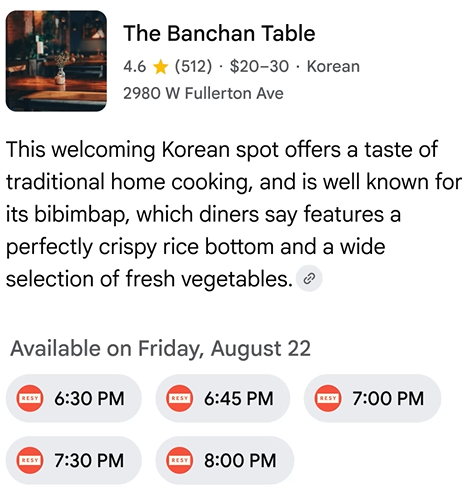
Source: Google
Once clicked, AI Mode loads a second menu confirming the details of the reservation, while offering a space to leave special requests. Users then simply press ‘Reserve’ to complete the process.
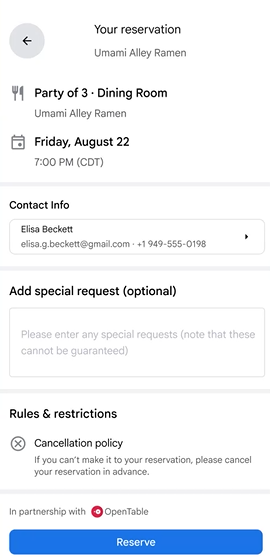
Source: Google
For site owners…
With OpenAI’s agentic ChatGPT picking up steam, Google will be keen to get more of these AI Mode features out quickly. Combined, these tools will begin popularising agentic search, so it’s crucial that your key web pages and user journeys are discoverable and actionable for agentic AI.
Websites that aren’t discoverable will simply not be in the running for inclusion in an agent’s outputs.
🟡 Research shows traditional search use is not in decline
Research published on SparkToro shows that traditional search use is highly stable in the US.
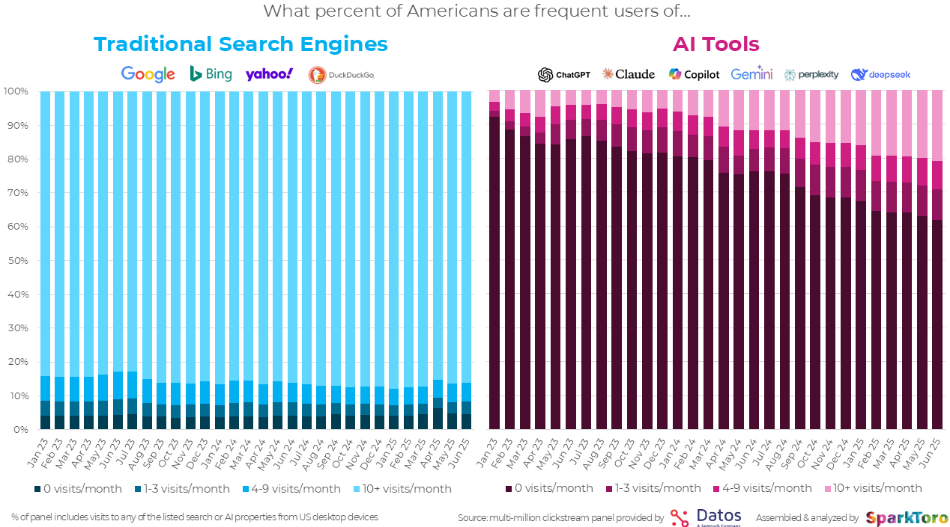
Source: SparkToro
This isn’t to say that people aren’t using AI mode, Copilot, ChatGPT, Perplexity, etc.; the report also revealed that over 20% of Americans now use AI search tools 10 times or more each month.
The data instead suggests that, while AI uptake is growing, people are still using standard search roughly the same amount they were in January 2023. In fact, use rates have been incredibly stable over the entire date range of the study.
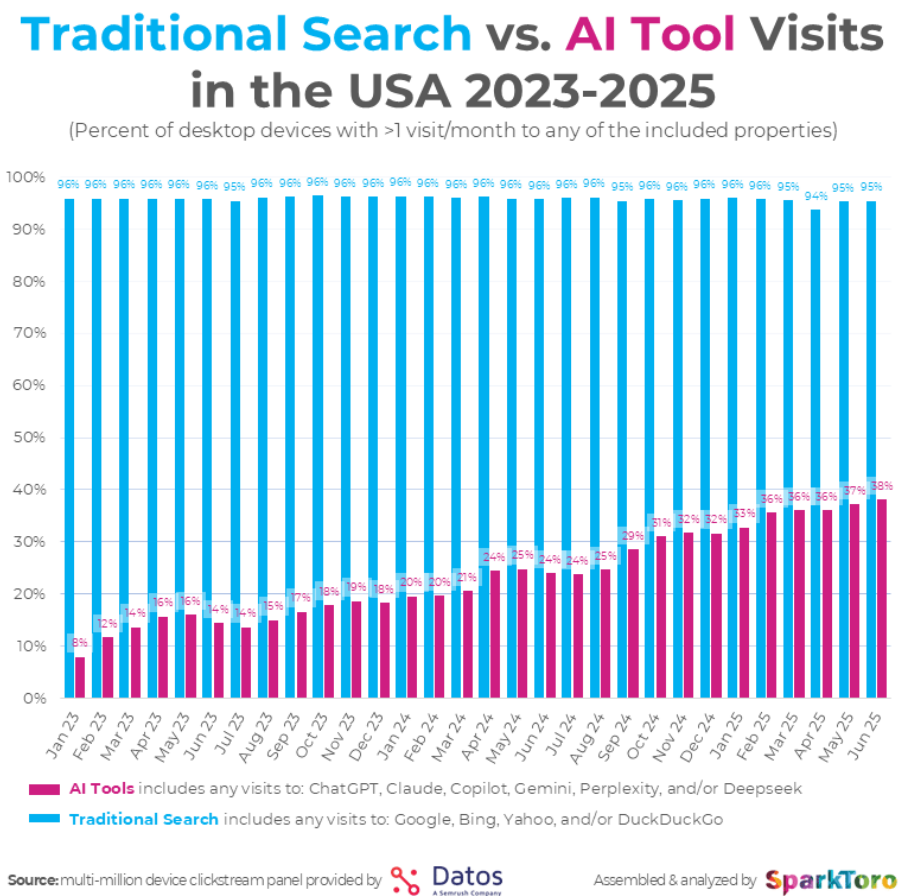
Source: SparkToro
For site owners…
This again brings to attention what TDMP and others have been saying since AI search became a reality: SEO is still essential.
While it’s becoming more important to be visible in AI generated outputs (as indicated by those rising red bars on the above chart), that doesn’t mean that traditional search is becoming less important; Google’s SERPs should remain your bread and butter for the time being - but it's also important to consider how AI search tools assess and cite content, so you can work learnings into your SEO strategy.
🟡 AI Mode outputs to become more “click-friendly”
Google has reported that they will soon be testing ways to increase clicks to websites from AI Mode’s generated outputs.
According to Google’s Robby Stein, this will include:
- Embedded link carousels in both desktop and mobile outputs.
- Inline links. These are the links embedded directly in the text of an output - far more visible and immediate than other link styles.
- Web Guide in the ‘All’ tab - instead of just the ‘Web’ tab. Web Guide simply restructures the usual search results page into more digestible sections, similar to an AI Mode output, but focusing on the usual 10 blue links.
For site owners…
This is of course good news. Google has been tinkering with links in both AI Overviews and AI Mode for some time, often making them less visible or actionable, so it’s great to hear that there will now be a focused effort on increasing clicks from AI Mode outputs.
But only websites being cited will be in the running for these clicks - contact TDMP today for support building visibility in AI-generated search results.
🟢 Google may tell publishers when users select them as “preferred sources”
Last month, Google launched a feature called Preferred Sources in the US and India that allows users to select the sites they want to see more from in their Top Stories feed.
And, for the first time in what seems like a long while, reception to a new Google feature was generally positive across the board. Land a spot on someone’s preferred sources list, and it seems reasonable to assume that Google will send them more frequently to your site. This, in the age of AI and “The Great Decoupling” of impressions and clicks, is a refreshing development.
However, with there being some real potential in this feature, publishers need to understand how to optimise for more “stars”, and to do that, they need transparency on how many Preferred Sources lists they’re on.
You could assume a certain amount of traffic uplift means you're earning more stars, but without a dedicated metric in Search Console, you’d never really know.
Google apparently agrees that this would make a good addition, claiming ‘We’re looking into this.’
🟢 Google struggles to identify certain paywalled content
In an addition to their JavaScript search documentation, Google explained that it has trouble understanding if content is behind a paywall when the full content is loaded in the initial server response and then obscured by a JavaScript interstitial.
According to Google, ideally, the full content should only be present once a user has taken the required action to gain access.
For site owners with paywalled content…
If Google mistakenly thinks your articles are freely available, it may index and display them in part or in full within search results. That undercuts your paywall, discourages subscriptions, and can hurt revenue.
To avoid problems, site owners should:
- Use structured data – Add the NewsArticle schema with paywall markup so Google knows which parts of your content are restricted.
- Serve content correctly – Don’t load the full article in the initial HTML if it’s meant to be paywalled. Instead, only load the teaser or intro, and display the full content after the user takes the required action (e.g., logging in or subscribing).
- Test your setup – Use Google’s URL Inspection tool in Search Console to see how Googlebot is rendering your content. If the bot sees the full article without restrictions, it’s a red flag.
- Review interstitials – If you’re using pop-ups or JavaScript overlays, make sure they’re implemented in a way that doesn’t confuse Googlebot.
SEO
🟡 Google explains why Chrome and Search Console UX Data don’t match
Chrome UX reports often don’t align with UX metrics in Search Console. Google clarified in August that this is because the platforms are focused on slightly different metrics.
The majority of Chrome UX data is based on webpage delivery during page views, tracking if the load time for each view is good, average, or slow. Therefore, the score given in a Chrome UX report relates only to pages that have been viewed. For instance, if all your views were for your homepage, that’s what the data relates to.
On the other hand, Google Search Console UX data pulls from all URLs, whether they receive visitors or not.
In short, Chrome focuses on page views, while Search Console focuses on pages.
For site owners…
Both reports are valid and accurate; they’re just measuring UX from slightly different angles.
Instead of wondering which one to focus on, consider them both, separately. They each offer a unique insight that can guide specific website optimisations.
Chrome’s focus on your most visited webpages in isolation lets you know how well your most important pages are performing in terms of vitals. If your score goes down, you need to focus optimisation efforts on your big hitters.
Search Console’s holistic focus gives you a more complete understanding of core vitals across your entire website, highlighting slower areas that, while not heavily trafficked, may receive more visitors once optimised.
🟡 Survey suggests AI Overview impact on clicks is minimal - but can it be trusted?
The studies showing AI Overviews reducing traffic to websites keep on coming, but a May 2025 survey from NP Digital appears to suggest AIO isn’t as harmful to your clicks to the degree the evidence suggests.
Instead of analysing clicks and impressions data, NP Digital reached out to searchers, asking them directly how likely they are to click on a traditional blue link after reading an AI Overview.
The majority of respondents claimed to click on a link “sometimes”, 30% said “often”, 13% said “always”, 10% said rarely, and only 4.4% of respondents reported that they “never” click on a link after reading an AI Overview.
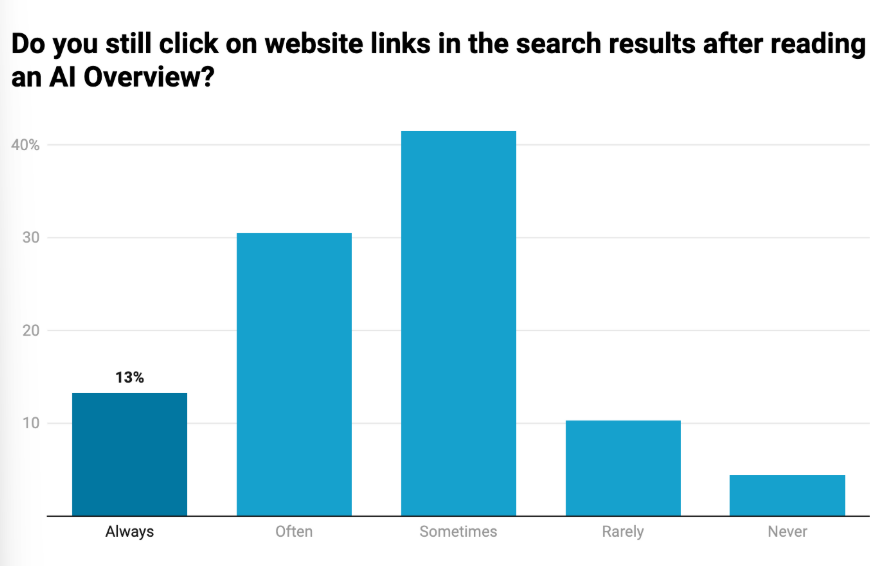
Source: PressGazette
However, very little information about the respondents has been revealed. There were 1000 of them. They live in the USA. They are adults. They were surveyed via Pollfish on behalf of NP Digital… that’s all that’s been reported.
Being that the results of the survey contradict those of numerous well publicised and data-backed studies, some are concerned that respondent demographics may be skewing the results.
🟡 LLMs seem to prefer AI content
A peer-reviewed PNAS study shows that large language models (LLMs) often “favour” content produced by AI over strictly human-produced content.
The study presented various AI systems with human- and AI-written versions of the same content items in three different categories:
- Marketplace product descriptions
- Scientific paper abstracts
- Film plot summaries
In all three cases, LLMs preferred the AI-written content, with averages differing by category:
- Product description: 89% for AI | 36% for humans
- Paper abstracts: 78% for AI | 61% for humans
- Plot summaries: 70% for AI | 58% for humans
For content creators…
This means that LLMs may be more likely to use and cite AI-assisted copy in their outputs, whether they be chat assistants, marketplaces, or search tools like ChatGPT.
Therefore, using AI responsibly during content creation, to augment rather than create from scratch, the final product, could result in improved visibility in AI-generated search results.
Be wary, though; LLMs are evolving rapidly, as are search engine algorithms. LLMs may prefer AI-generated content now, but there’s no way of knowing the same will be true in a year, a month, or even a week’s time.
Additionally, the differing preference averages for different content types is important. The study only tested three forms. LLMs may well prefer human-produced versions of other forms.
Paid media
🔴 Google to release ads in AI Mode in the US before Q4
Some slides have come to light from a Google pitch on ads in AI Mode. The slides (pictured below), explain that ads in AI Mode will take the form of text and shopping ads relevant to both the user query and the AI-generated response.
According to a social post from Glenn Gabe, Google will go live with AI Mode ads in the US before Q4, after a lengthy testing period that began back in May.
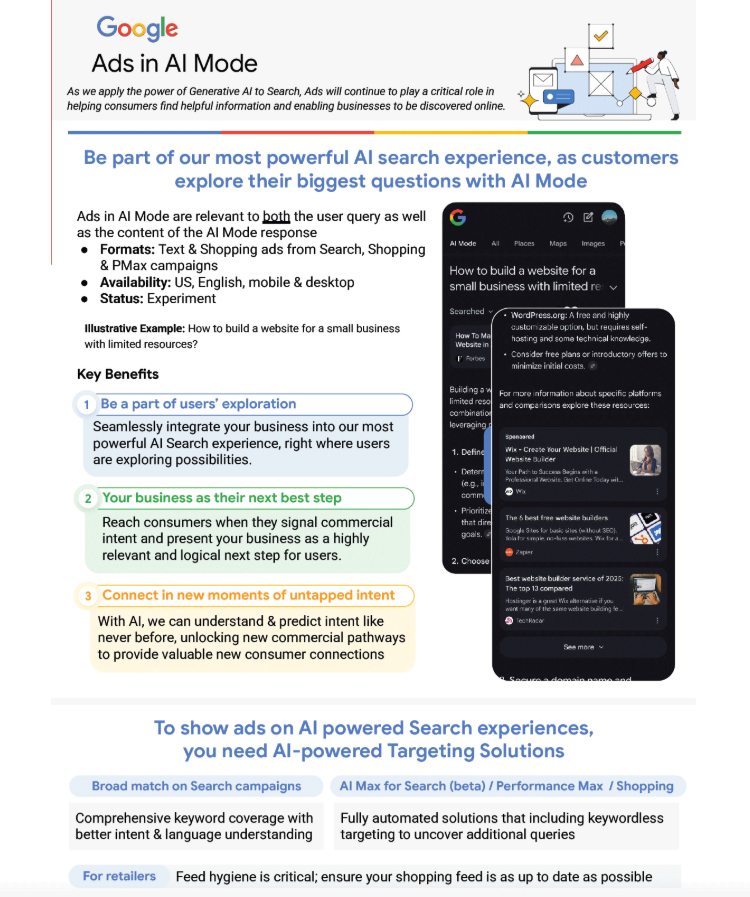
Source: Search Engine Roundtable
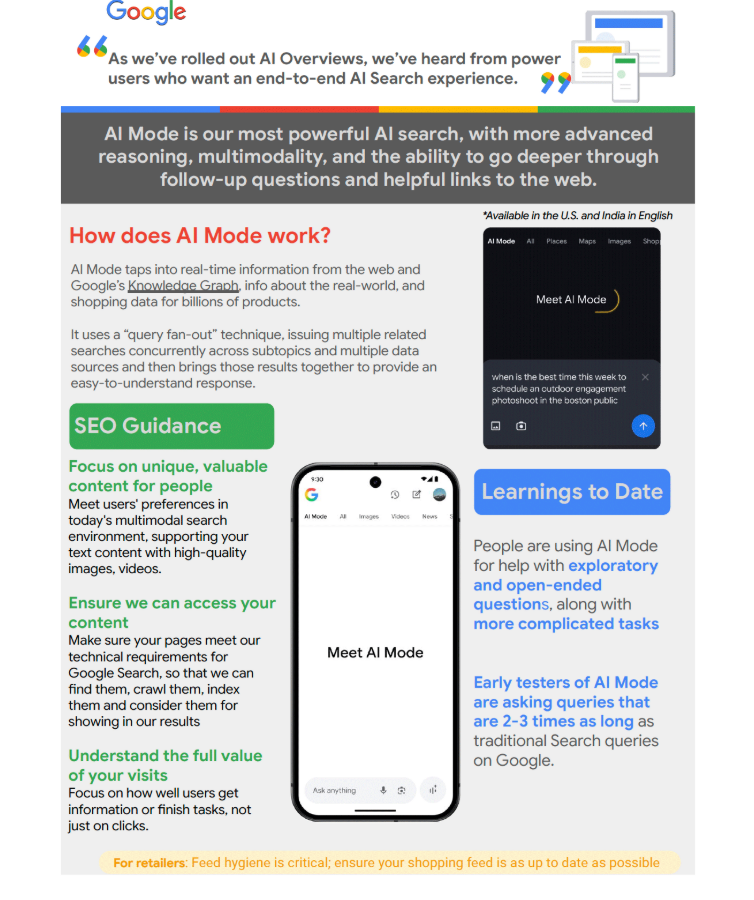
Source: Search Engine Roundtable
For UK advertisers…
Google hasn’t confirmed a launch date for AI Mode ads in the UK, but they won’t want to drag their tail on anything that could help them keep breaking ad revenue records.
Most likely, Google will gather and assess data from the US launch over the next few months before launching overseas. So, expect AI Mode ads to hit the UK either late in Q4 or early Q1, 2026.
With AI Mode interactions being so rich in context, if Google executes well, ads in this space could be hyper relevant to users, which should increase meaningful engagement. Unfortunately, though, it doesn’t look like there will be any separate performance reporting for ads in AI Mode, which will make it difficult to assess how effective ads are in this new space.
It’s also worth noting that, although these slides were part of a “pitch”, there is no hard sell. As far as the industry is aware, short of avoiding Broad Match and AI Max targeting, you cannot choose not to show ads in AI Mode. Just like with ads in AI Overviews, there is no opt out option.
🟢 Google clarifies role of negative keywords in smart bidding
When asked whether negative keywords are used to help “train” Smart Bidding, Ginny Marvin explained that negative keywords are not used the same way positive signals are. Instead, they serve as eligibility criteria: if a search query matches your negative list, the ad is simply not eligible to show.
Unlike positive keywords, which are interpreted with the help of intent-based technologies like Gemini, negative keywords are evaluated literally. This means the system checks for the specific words themselves, without trying to interpret their broader meaning. By filtering out unwanted traffic at the eligibility stage, negatives prevent irrelevant searches from reaching your campaign in the first place.
For advertisers…
A strong negative keyword strategy helps maintain cleaner signals for Smart Bidding to optimise against, ensuring your budget goes toward the most valuable queries without unintentionally limiting reach.
If you'd like support getting the most out of your paid media campaigns, contact TDMP. We're a Google Premier Partner PPC agency with an extensive track record of delivering outstaning results for clients.
🟢 Google introduces new PMax features
Google has rolled out a set of new controls and reporting features for Performance Max campaigns, giving advertisers more flexibility in managing campaigns and clearer insights into performance.
Key updates include:
- Campaign-level negative keyword lists: Easily apply exclusions across multiple campaigns.
- Expanded search theme limits: Increase from 25 to 50 per asset group.
- More demographic targeting options: Age exclusions, device targeting, and a new beta for gender exclusions.
- Improved customer acquisition reporting: More accurate identification of new vs. existing customers (no more “Unknown” conversions).
- Goal diagnostics: New tools to identify and resolve issues like missing tags or conversion setup errors.
- Final URL expansion assets reporting: Visibility into auto-generated assets, with the ability to review or remove them.
- Creative recommendations: AI-driven suggestions to improve image quality and performance across channels.
Security
🔴 WordPress plugin security vulnerability affecting around 600,000 sites
A security vulnerability in the popular WordPress plugin Ocean Extra has been identified, leaving roughly 600,000 sites at risk of stored XSS attacks.
In plain English, this means bad actors can upload malicious scripts that trigger when a user visits the website.
The vulnerability is caused by the plugin’s lack of input sanitisation and output escaping systems:
- Input sanitisation – A filter that prevents unexpected inputs from being accepted by the system. For example, it checks and cleans user-provided data so attackers can’t sneak in harmful code or commands.
- Output escaping – A safeguard that makes sure any data sent from the website to a user’s browser is displayed only as plain text, not executed as code. This prevents malicious scripts from running if they somehow slip through input checks.
The vulnerability is limited in that it only affects authenticated users with contributor-level access, but the issue needs to be addressed ASAP.
For WordPress site owners…
Fortunately, there’s a simple fix. Just update the extension to its latest version (2.5.0). The vulnerability is only present in versions 2.4.9 backwards.
If you’re not sure if you’re running the Ocean Extra plugin on your WordPress site, here’s how you can check:
- Log in to your WordPress dashboard.
- In the left-hand menu, go to Plugins → Installed Plugins.
- Look through the list for Ocean Extra.
- If it’s there, check the version number listed under the plugin name.
If it shows 2.4.9 or lower, you’ll want to update immediately to 2.5.0 to patch the vulnerability.
Stay current with TDMP
That wraps up August’s search industry updates. With Google continuing to balance AI innovation against traditional search, and new ad and SEO developments landing almost weekly, staying informed is more important than ever.
Contact TDMP today for comprehensive digital marketing support.

